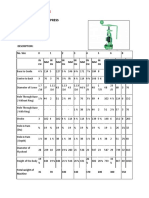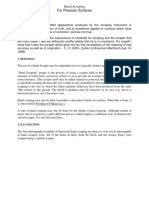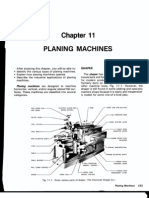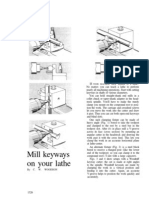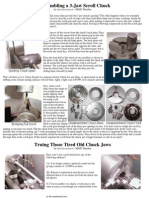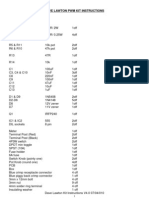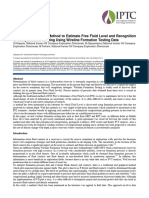The Shape of The Cone of The Twist Drills Unit-2
The Shape of The Cone of The Twist Drills Unit-2
Uploaded by
Akesh KakarlaCopyright:
Available Formats
The Shape of The Cone of The Twist Drills Unit-2
The Shape of The Cone of The Twist Drills Unit-2
Uploaded by
Akesh KakarlaOriginal Description:
Original Title
Copyright
Available Formats
Share this document
Did you find this document useful?
Is this content inappropriate?
Copyright:
Available Formats
The Shape of The Cone of The Twist Drills Unit-2
The Shape of The Cone of The Twist Drills Unit-2
Uploaded by
Akesh KakarlaCopyright:
Available Formats
The shape of the cone of the twist drills
With reference to figure N1 we can give the following definitions:
Fig. N1- Some characteristic angles of twist drill : Helix angle; it is formed by the tangent of the medium helix with the axis of the drill tip . Its value is much smaller than the harder the material to be drilled. : Point angle; it is the angle formed by the two main cutting edges. : Upper rake angle : Cutting rake angle : Lip relief angle. Cone of the re-sharpening means the end of the drill tip which has the task of removing the chips. On this cone are made the re-sharpening. On the cone of the re-sharpening are distinguished two other angles, in addition to those described just above.
Fig. N2 Characteristic angles of the cone of re-sharpening = Lip relief angle (measured on the periphery) = Chisel edge angle (inclination of the transversal cutting edge) Lip relief angle As already mentioned, the cutting edge traveling a helical path which, in addition to increasing rake angle has the effect of decreasing the lip relief angle.
The amount of variation of the angle is:
where
Proceeding towards the top of the cone, therefore, the angle grows up to become infinite on the axis . This leads to two considerations: 1) To be effective the lip relief angle should be variable in the opposite direction to the variation of , which will be greater towards the center. 2) Near of the axis the angle cannot be large enough and in this area then there will be the maximum resistance to penetration. It would therefore be appropriate to assign the maximum value of angle , but it must always be kept within limits which are not too high because otherwise the cutting rake angle would become too small and the cutting edge would deteriorate quickly. The lip relief angle depends from the feed adopted: to a higher feed, must correspond a greater relief angle. With the values of the feed per revolution commonly used, the recommended values of the angle measured on the periphery are indicated in tableN1.
Table N1
Material machined Steel with R 700 N/mm2 Steel with R = 700 900 N/mm2 Steel with R = 900 1100 N/mm2 Cast iron with hardness 200 Hb Cast iron with hardness 200 250 Hb Bronze Copper , Brass Aluminum aloys
Lip relief angle 12 9 7 10 - 12 9 12 15 15 - 18
It is also possible to sharpen the tip with an angle growing from the periphery to the center: this will be discussed later. Point angle From the value of this angle depends the length of the cutting edges, in fact, there are:
Therefore, the lower the point angle, the length of the cutting edges increases, on the other hand we have: The effort of penetration decreases with decreasing the point angle. The radial force increases if the length of the cutting edges increases, ie if the angle decreases. Therefore it is evident that between the two opposing needs you will find a compromise that leads maximum efficiency. The angles that give the highest efficiency were found through tests in the workshop conducted by specialized firms in the construction of this type of tool, and they are summarized in Table N2 for the material to be drilled.
Table N2
Steel Cast iron Aluminum alloys Plastics with thickness less than the diameter
= 118 = 118 = 140 = 80
For drilling thin metal sheets are used drills with a reinforced web and very short (UNI 3580); in addition to prevent breakage is increased the value of the point angle enough to allow that the cutting edges to be completely penetrated in the material before the chisel edge comes out of the hole. With reference to figure N3 we have:
Fig. N3- Drilling of thin metal sheets Chisel angle (inclination of the transversal cutting edge) The transversal cutting is the edge resulting from the intersection of the two surfaces of sharpening. Through the inclination of the transversal cutting edge can be understood if the sharpening was done correctly. In the normal drills with lip relief angle of 12, the angle is approximately 35.
Web thickness The web is the central portion of the drill, the one that has to resist the torsional stresses generated by the in the action of cutting.
Fig. N4 The web is an obstacle to penetration of the drill in the piece and then a drill bit with very thin the web, having the chisel edge very short, penetrates more easily. But on the other hand, it is necessary to ensure sufficient torsional strength to avoid breakage. From these conflicting requirements it follows that the sizing of the web is very delicate operation that must take into account a variety of factors.
In order to allow an easier penetration and at the same time have the highest resistance to torsion, in general the web is constructed with a slightly conical section near the tip of the cutting edge. The factors that influence the choice of the thickness of the web (ie near the edges) and the taper can be summarized as follows: Diameter of the drill Length of the helical part Type of work to do The thickness of the web in relation to the diameter of the drill, is determined by the table DIN 1414 with the values shown in figure N5. For each diameter there are three web thicknesses to be chosen based on other factors.
Web thickness
Diameter
Fig. N5- Thickness of the web function of the nominal diameter Table N3 indicates, for each type of twist drill bit (cylindrical short range, long range, with taper shank) the taper of the web as a percentage (%), depending on the diameter. The values of the taper of the web are derived from those provided by internal normalization of manufacturers of twist drills. In special cases, in which efforts are more extensive than normal , it is necessary to build the drills with reinforced web. In these cases, in order to avoid a strong resistance to penetration, it is necessary to use special types of sharpening. The most common cases where it is necessary to reinforce the web are: Drilling deep hole of hard and tough material (length/diameter ratio = 4:1). Drilling of thin metal sheets.
Table N3-
Values of the taper of the web in % for drills of short range, long range, with taper shank Diameter Taper of web % Diameter Taper of web %
1 2 3 4 5 6 7 8 10 12 14 1,20 1,60 1,67 1,71 1,73 1,75 1,77 1,78 1,80 1,81 1,82 16 18 20 22 24 26 28 30 32 35 40 1,83 1,84 1,85 1,86 1,87 1,88 1,89 1,90 1,90 1,90 1,90
You might also like
- Sharpening Lathe ToolsDocument9 pagesSharpening Lathe ToolsitzliehecatlNo ratings yet
- 1946 Rusnok Mill Heads CatDocument25 pages1946 Rusnok Mill Heads CatfgrefeNo ratings yet
- Quorn User ManualDocument31 pagesQuorn User ManualGeorge Stright100% (7)
- Southbend Shaper V2 Parts ListDocument6 pagesSouthbend Shaper V2 Parts ListStephen HowardNo ratings yet
- Fly Press CatalogDocument2 pagesFly Press CatalogAmit GaragNo ratings yet
- RCH Business Plan 092009 PDFDocument20 pagesRCH Business Plan 092009 PDFMuhammad Agung Bhagaskoro100% (1)
- Labview Advanced CourseDocument590 pagesLabview Advanced CourseHildana Pacheco Fariñas100% (4)
- A Practical Workshop Companion for Tin, Sheet Iron, and Copper Plate Workers: Containing Rules for Describing Various Kinds of Patterns used by Tin, Sheet Iron, and Copper Plate Workers, Practical Geometry, Mensuration of Surfaces and Solids, Tables of the Weights of Metals, Lead Pipe, Tables of Areas and CircumferencesFrom EverandA Practical Workshop Companion for Tin, Sheet Iron, and Copper Plate Workers: Containing Rules for Describing Various Kinds of Patterns used by Tin, Sheet Iron, and Copper Plate Workers, Practical Geometry, Mensuration of Surfaces and Solids, Tables of the Weights of Metals, Lead Pipe, Tables of Areas and CircumferencesNo ratings yet
- Bonelle GrinderDocument11 pagesBonelle Grinderjohnjohn5250% (2)
- Gear Hob BasicsDocument6 pagesGear Hob BasicsAnkur Jain100% (1)
- For Precision Surfaces: Hand ScrapingDocument8 pagesFor Precision Surfaces: Hand ScrapingnarendragahlotNo ratings yet
- Dbs22 enDocument14 pagesDbs22 enmilivoj11100% (1)
- Making The Keats Angle Plate From CastingsDocument15 pagesMaking The Keats Angle Plate From CastingsJohn SmithNo ratings yet
- How To Make A Simple Sinker EDM For Under $100Document9 pagesHow To Make A Simple Sinker EDM For Under $100ryanrenzeNo ratings yet
- KO Lee A600 BrochureDocument6 pagesKO Lee A600 BrochureRobert W. Lamparter100% (1)
- South Bend 9" Compound Slide Screw Fabrication For A Large Dial/Thrust Bearing Conversion by Ed Godwin 8 December, 2007Document16 pagesSouth Bend 9" Compound Slide Screw Fabrication For A Large Dial/Thrust Bearing Conversion by Ed Godwin 8 December, 2007asdfNo ratings yet
- Shaper Cut GearsDocument5 pagesShaper Cut GearstaiwestNo ratings yet
- SHOP THEORY-Engine Lathe ProcessesDocument54 pagesSHOP THEORY-Engine Lathe ProcessesDaxNo ratings yet
- MyfordDocument1 pageMyfordPeanut d. DestroyerNo ratings yet
- Shaper Chapter From Manufacturing TechnologyDocument8 pagesShaper Chapter From Manufacturing Technologygaurav110790No ratings yet
- Resharpening of The Twist Drill BitsDocument5 pagesResharpening of The Twist Drill BitsJuanGómezNo ratings yet
- Quorn: Tool and Cutter GrinderDocument4 pagesQuorn: Tool and Cutter GrinderDan HendersonNo ratings yet
- Drill BitsDocument23 pagesDrill BitsIndah CharismasariNo ratings yet
- Belt SanderDocument2 pagesBelt SanderFrenchwolf420No ratings yet
- Twist DrillDocument7 pagesTwist DrillMartinus Oda AdiNo ratings yet
- Grinding Your Own Lathe ToolsDocument9 pagesGrinding Your Own Lathe Toolsredneckrepairs100% (1)
- Machinery's Handbook 28 Edition - WHITWORTH THREADSDocument3 pagesMachinery's Handbook 28 Edition - WHITWORTH THREADSPatricia Carolina LimaNo ratings yet
- Drill Grinder Instructions 0CECFEC7086BDDocument8 pagesDrill Grinder Instructions 0CECFEC7086BDMIGUEL ANGEL GARCIA BARAJASNo ratings yet
- Making It Dead Flat and SquareDocument9 pagesMaking It Dead Flat and SquareSimon Uwtvuur100% (3)
- ID 102 Engineering Practice: Indian Institute of Technology HyderabadDocument55 pagesID 102 Engineering Practice: Indian Institute of Technology HyderabadSumit JadhavNo ratings yet
- BME Lecture 5 ShaperDocument6 pagesBME Lecture 5 ShaperRoop LalNo ratings yet
- Balancing Grinder WheelsDocument8 pagesBalancing Grinder WheelsmountaineerjpNo ratings yet
- South Bend Lathe Works - Shifting Cone Pulley and Adjusting Belt TensionDocument1 pageSouth Bend Lathe Works - Shifting Cone Pulley and Adjusting Belt TensiontrollforgeNo ratings yet
- SICS ... : Basic Gear DesignDocument9 pagesSICS ... : Basic Gear DesignadamtuongNo ratings yet
- How To Make Your Own Belt Sander - CompressDocument34 pagesHow To Make Your Own Belt Sander - CompressKieth Edward Norrena100% (1)
- HSS Lathe Tool Grinding: Steve S WorkshopDocument11 pagesHSS Lathe Tool Grinding: Steve S Workshop208048022No ratings yet
- Designing Gear CuttersDocument3 pagesDesigning Gear CuttersKrishnadev Madhavan NairNo ratings yet
- Automatic Screw Machine Practice: Machinery'S Reference SeriesDocument45 pagesAutomatic Screw Machine Practice: Machinery'S Reference SeriesKurtis FascianoNo ratings yet
- Balanci GrindingDocument18 pagesBalanci GrindingAnonymous JzEb8CXEr100% (1)
- Cutter Making David CreedDocument19 pagesCutter Making David CreedBruno Delsupexhe100% (1)
- Right Angle HeadDocument13 pagesRight Angle Headkwayneolson6081100% (4)
- Cutting Tools & Tool HoldersDocument38 pagesCutting Tools & Tool HoldersWilliam Salazar100% (1)
- Bolt Together LatheDocument7 pagesBolt Together Lathe69x4No ratings yet
- On Cnczone: German Epoxy Granite Milling Machine Here'S An Awesome Project I Recently Heard AboutDocument10 pagesOn Cnczone: German Epoxy Granite Milling Machine Here'S An Awesome Project I Recently Heard AboutYamith GomezNo ratings yet
- Universal Tool and Cutter Grinder Manual Low ResDocument16 pagesUniversal Tool and Cutter Grinder Manual Low ResDale Wade100% (1)
- Quick Change Gearbox: Instructions For Installation and Operation Pictorial Parts ListDocument10 pagesQuick Change Gearbox: Instructions For Installation and Operation Pictorial Parts ListfejlongNo ratings yet
- Atlas Mill AccessoriesDocument1 pageAtlas Mill AccessoriesGary RepeshNo ratings yet
- Mill Keyways On LatheDocument1 pageMill Keyways On LatheJim100% (4)
- Grinding Lathe ToolsDocument18 pagesGrinding Lathe ToolsAntónio FrançaNo ratings yet
- 3 Jaw Chuck RepairDocument2 pages3 Jaw Chuck RepairbrianatburleighNo ratings yet
- Benchworking StudyDocument100 pagesBenchworking StudyBrianRuaro100% (1)
- A Few Project Images: Tool Posts Lathe Cutting ToolsDocument4 pagesA Few Project Images: Tool Posts Lathe Cutting ToolsAnonymous mKdAfWifNo ratings yet
- 33 - Making Clocks PDFDocument65 pages33 - Making Clocks PDFBruno DelsupexheNo ratings yet
- Lathe MachineDocument12 pagesLathe MachineHermilih SiregarNo ratings yet
- Rebuilding My Monarch 10EE LatheDocument5 pagesRebuilding My Monarch 10EE Lathesyllavethyjim100% (2)
- Quorn: Tool and Cutter GrinderDocument5 pagesQuorn: Tool and Cutter GrinderDan Henderson100% (1)
- Grinding Lathe Tools On A Belt Sander - For The New Guy - MachinistBlogDocument13 pagesGrinding Lathe Tools On A Belt Sander - For The New Guy - MachinistBlogredneckrepairs100% (1)
- Turning Lathes - A Manual For Technical Schools And Apprentices - A Guide To Turning, Screw-Cutting Metal SpinningFrom EverandTurning Lathes - A Manual For Technical Schools And Apprentices - A Guide To Turning, Screw-Cutting Metal SpinningRating: 2.5 out of 5 stars2.5/5 (2)
- Structural Analysis of Car Disk BrakeDocument73 pagesStructural Analysis of Car Disk BrakeAkesh KakarlaNo ratings yet
- Structural Analysis of Crane HookDocument5 pagesStructural Analysis of Crane HookAkesh KakarlaNo ratings yet
- LM-12 Machine Tools, MT, AMS, Manufacturing SystemsDocument11 pagesLM-12 Machine Tools, MT, AMS, Manufacturing SystemsAkesh KakarlaNo ratings yet
- LM-06 Machine ToolsDocument12 pagesLM-06 Machine ToolsAkesh KakarlaNo ratings yet
- Tina London's Guidelines and Good Practice Guide For Developing SQLDocument39 pagesTina London's Guidelines and Good Practice Guide For Developing SQLAkesh KakarlaNo ratings yet
- Oracle Ask TomDocument40 pagesOracle Ask TomAkesh KakarlaNo ratings yet
- Dave Lawton PWM Kit Instructions 2Document7 pagesDave Lawton PWM Kit Instructions 2Ciro GiordanoNo ratings yet
- New Method To Estimate FFL With WFT DataDocument10 pagesNew Method To Estimate FFL With WFT DataPaolo MartiniNo ratings yet
- The Harvard Law Review Association Harvard Law ReviewDocument40 pagesThe Harvard Law Review Association Harvard Law ReviewUtty F. SeieiNo ratings yet
- Registros ATV71Document110 pagesRegistros ATV71jean carlos senmache torresNo ratings yet
- Cell StructureDocument63 pagesCell StructurelfagioliNo ratings yet
- Seductress GameDocument14 pagesSeductress GameBarbaraNo ratings yet
- Tds Polintek L&P Plus For Metal-Dmi IndustriDocument1 pageTds Polintek L&P Plus For Metal-Dmi IndustriYosep SasadaNo ratings yet
- Tech Doc RFDocument9 pagesTech Doc RFwrite2arshad_mNo ratings yet
- PRM-Individual AssignmentDocument2 pagesPRM-Individual AssignmentDeeNo ratings yet
- Procedure On FTADocument24 pagesProcedure On FTAKrishna Kumar AlagarNo ratings yet
- Programme Schedule - Icache-2018 International Conference On ADVANCES IN CHEMICAL ENGINEERINGDocument4 pagesProgramme Schedule - Icache-2018 International Conference On ADVANCES IN CHEMICAL ENGINEERINGzakirchemNo ratings yet
- Foundation On Expansive Soils PresentationDocument11 pagesFoundation On Expansive Soils PresentationsamirNo ratings yet
- Sir. Linex Fluid MachineryDocument160 pagesSir. Linex Fluid MachineryBrian Montes Bagarinao100% (1)
- PFD Unit 2000 - ReferenceDocument2 pagesPFD Unit 2000 - ReferenceAgravante JakeNo ratings yet
- Transculturalism and Transcultural Liter PDFDocument211 pagesTransculturalism and Transcultural Liter PDFLucas Accastello ChNo ratings yet
- Duke Review of MRI Physics by Wells Mangrum, Quoc Bao Hoang, Tim Amrhein, Scott Duncan, CharlesDocument267 pagesDuke Review of MRI Physics by Wells Mangrum, Quoc Bao Hoang, Tim Amrhein, Scott Duncan, CharlesMerah Bagus Yuswiranda BNo ratings yet
- 2.7.2 Employee Satisfaction SurveyDocument4 pages2.7.2 Employee Satisfaction SurveyHassan IkhlaqNo ratings yet
- Ontario Public LibraryDocument57 pagesOntario Public Librarydenizcosta100% (1)
- 3rd Grade Eight Week PlanDocument52 pages3rd Grade Eight Week PlanJennifer AuxierNo ratings yet
- Little RabbitDocument6 pagesLittle RabbitHsjsjdejhsNo ratings yet
- Organic Field Effect TransistorsDocument19 pagesOrganic Field Effect TransistorsAravindNo ratings yet
- Position Analysis of Higher-Class Assur Groups byDocument8 pagesPosition Analysis of Higher-Class Assur Groups byPedroNo ratings yet
- Evaly CyclonehDocument1 pageEvaly CyclonehGolam Mohammed ChowdhuryNo ratings yet
- Derivatives Pricing Using QuantLib - An IntroductionDocument25 pagesDerivatives Pricing Using QuantLib - An Introductionvicky.sajnaniNo ratings yet
- Module 5Document14 pagesModule 5Shweta JambhulkarNo ratings yet
- Recent Ielts TopicsDocument15 pagesRecent Ielts TopicsJosé Sermeño100% (1)
- Mutant MT1202R ManualDocument24 pagesMutant MT1202R Manualbull jackNo ratings yet
- Artificial Supercavitation. Physics and CalculationDocument34 pagesArtificial Supercavitation. Physics and Calculationmohsen123No ratings yet




